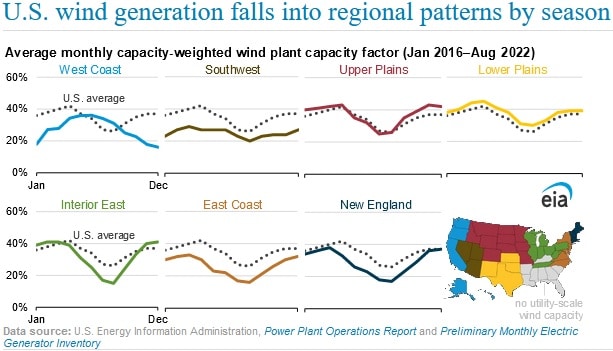U.S. Wind Generation Varies Significantly Across Regions Due to Geographic Differences, Season: EIA

Across the U.S. between January 2016 and August 2022, wind plant capacity factors reached their highest levels in March and April and were at their lowest in July and August, according to a Nov. 30 report by the U.S. Energy Information Administration.
Geographical variations in wind resource potential implies wind production varies significantly across regions. The Lower Plains region of Texas, Oklahoma, Kansas, and New Mexico has the greatest proportion of U.S. wind capability, at 44 percent as of August 2022. As a result, of this large concentration, the national wind performance trends strongly follow the seasonal and wind performance arrangement of the Lower Plains region. Wind performance is reported by the agency to peak in the spring and decline in summer and increase again in the fall and winter.
The Upper Plains region has the second largest proportion of U.S. wind capability at 29 percent and data shows the region closely follows a similar seasonal trend as the Lower Plains. The Interior East Region, which makes up 13 percent of U.S. wind capacity also follows a similar trend but experiences a significant decline in the summer months compared to both the Lower and Upper plains.
The seasonal pattern is starkly distinct in the West Coast region which consists of 10 percent of U.S. wind capability. In this region, wind generation is driven mostly by a large number of wind assets in California. Wind capacity factors in the West Coast region increase late in the spring and reach their highest levels in the summer months before gradually falling into the fall and winter. The Southwest, East Coast, and New England make up 4 percent of the U.S. wind capability. In these regions capacity factors were marginally lower than the U.S. average.
Wind plant performance is essentially determined by the accessibility of wind supplies, which differ depending on two key factors: time of year and geographic region. The performance of a wind power asset is often measured by its capacity factor, which determines the highest possible production in a given time period.
Wind generation is essentially affected by available wind supplies, and is impacted by wind speed, wind direction, wind constancy and turbine height; this is in contrast to other fossil fuel fired power plants, which rely on fuel costs to generate electricity.
EnerKnol Pulses like this one are powered by the EnerKnol Platform—the first comprehensive database for real-time energy policy tracking. Sign up for a free trial below for access to key regulatory data and deep industry insights across the energy spectrum.
ACCESS FREE TRIAL